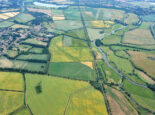Peterborough’s very own Deep-Sea Monster
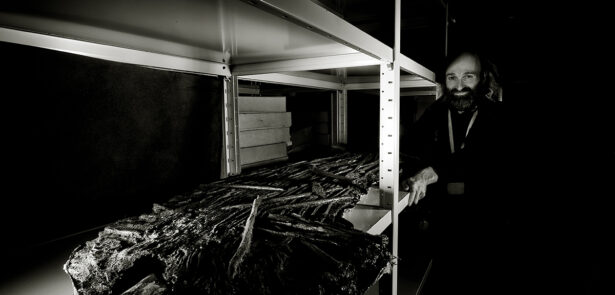
If Peterborough Cathedral’s Monsters of the Sea exhibition has ‘wet’ your appetite for more giant prehistoric creatures, then head over to Peterborough Museum to find out about the biggest fish that ever lived – and how it was found in a nearby quarry!
When Victorian fossil hunter Alfred Nicholson Leeds found some tantalising bones in a Peterborough clay pit, it was initially believed they could only belong to a dinosaur, so great was their size. It was soon realised that they belonged to a Jurassic fish the size of a small whale. Conclusive evidence of this huge creature proved elusive, however – so much so that it earned the name Leedsichthys problematicus. Then, in 2001, palaeontologist Jeff Liston was sent a single bone from the same clay pits in which Leeds had originally dug, and the hunt was back on. What Jeff and his team ultimately came away with – a jigsaw puzzle of 2,300 bones and the subject of a huge project at Peterborough Museum – was more than just the catch of the day: it was the biggest fish that ever lived.
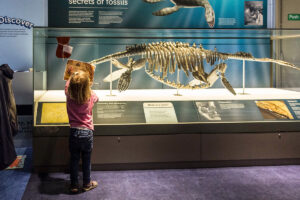 How did you first get involved with Leedsichthys?
How did you first get involved with Leedsichthys?
I was working in the Hunterian Museum at the University of Glasgow, curating a collection there from collector Alfred Nicholson Leeds. He’s from around here – he used to live down at Eyebury Farm – and basically, just as all the clay pits were starting to spring up around here for brickmaking, he was collecting all the fossils that were being exposed. Eventually, he amassed one of the largest collections of fossil vertebrates in the world – completely on his own in his attic in Eyebury – and none of these animals were really known to science. It so happened that he married a woman from Glasgow called Mary Ferrier Ferguson, and when he died, although much of his collection had gone to the Natural History Museum in London during his lifetime, the rest went up to the University of Glasgow.
We have about 650 examples of marine reptiles there just from his collection: marine crocodiles, plesiosaurs, pliosaurs, ichthyosaurs… But there was also this fish, called Leedsichthys, which nobody had ever done any work on, since it had originally been described. The Glasgow specimen, called Big Meg, was over 900 bits – just one animal, and very fragmentary, but even this, when laid out, ran the entire length of a corridor in our museum store. There was nothing to identify any of these bones. The original type description had been done in 1889 by a world-renowned fossil fish authority called Arthur Smith Woodward, yet it is the woolliest description you’ll ever come across! About five years later he published a paper in which he admitted that apart from the gill rakers [needle-like bones in the gills] and the fin rays [thin bones that support the fins], he hadn’t got a clue what any of the bones were. Well, I happened to be looking for a PhD subject, so decided Leedsichthys would be it.
Then, one year into the PhD, in July 2001, I was sent these bone fragments with the message ‘We believe we’ve got a Leedsichthys – can you confirm this?’ Two students from Portsmouth University, Matt Riley and Marcus Wood, had found bits of bone sticking out of a cliff in the Star Pit down by Whittlesey. So, as the only person that had seriously looked at this animal in over a hundred years, the fragments were sent to me. Sure enough, I took one look and said: ‘Yep, definitely Leedsichthys…’ and then came down here that October with Dave Martill, who was my supervisor at the time, and Alan Dawn, a local amateur geologist who volunteered working on fossil material in Peterborough Museum.
 What happened next?
What happened next?
We went down to the Star Pit, and marked out an eight-metre stretch of the cliff, along which I was able to find 13 different bones, which I was certain were Leedsichthys, protruding from the clay. We started to get excited, because it was looking like this could be the most complete specimen ever found. We did have one small problem, though, because although it was all quite nicely preserved, the bed had this inconvenient 20-metre high cliff sitting on top of it… So, by June the following year, we had obtained funding from the Palaeontological Association for a Komatsu digger to come in and take away the entire cliff until we were left with a big exposed area around 25 metres by nine metres; then over the next three months we excavated it, supported by funding from NERC’s emergency funding route, the Aggregate Levy Sustainability Fund, English Nature, Stamford Geological Society, East Midlands Geological Society and the Friends of Peterborough Museum. We were then just using dental tools to uncover very fine bones, so it took a very long time – but these were types of bones that had never been found before for this fish.
Is it true it was a pretty arduous excavation?
The area in which we found the bones of the animal was about 25 metres wide and six metres front to back. It contains the front end of the animal – the rest having probably been unknowingly taken away with the clay to make into bricks. We were having to work against the clock because we did not know if we would get a second chance to collect the specimen before the pit was disposed of by its owners, and there were so many bones that we were working at night as well, which brought certain problems. We were camped at the pit, by the railway line, and at 3am we’d get trains coming through, so it was difficult getting a solid night’s sleep. Then there was the unpredictable weather, which would occasionally turn the site into a mudbath, so some mornings we’d have to get up and before we could start excavating anything we’d have to pump it all out.
But we found the left and right pectoral fins, and the skull, and took everything away that we could, even coming back for more in the 2003 field season – giving us a mountain of 2,300 bones, the largest of which were protected in jackets of plaster, all excavated in 3,100 staff hours… We know we didn’t get it all out of that pit, either – there was more in there but the pit was flooded before we could get it all. Since then, the material has been here in Peterborough Museum, and the late Alan Dawn and his team of volunteers spent much of the next ten years preparing it: in total, they’ve spent another 11,750 hours of their own time thus far in preparing the bones.
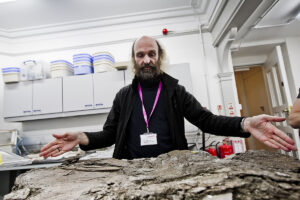 Why is this discovery so significant?
Why is this discovery so significant?
What it gives us is the first real opportunity to move beyond what Arthur Smith Woodward did, and start to see what this animal would really have been like, even reconstructing its skull. That was simply impossible before: people were just taking the one or two bones that were known and building a generic skull imagining the rest, but we have enough evidence here to create the first real, three- dimensional reconstruction. Living around 155 million years ago, the animal looks to be the biggest fish ever – certainly the biggest bony fish. It’s a suspension feeder, so it’s very like a whale shark or basking shark, feeding on plankton, from a family of fish called pachycormids which lived at the same time as the dinosaurs, during the Jurassic and Cretaceous periods. They had that niche that whale sharks, basking sharks and some whales occupy now, but all of these pachycormid fish disappeared with the K-T extinction event that wiped out the dinosaurs 66 million years ago. There’s no record of them after that.
Why so big?
It’s the only time that bony fish have ever really got big, so clearly conditions were just right during the Jurassic period. The growth of animals does have natural limitations. You know in films like Them! where they show you imaginary giant ants? One of the problems with that idea is that the size an insect can reach is dependent upon the size of creature their respiratory system can support. There’s a similar respiratory limitation with these fish. They respire using gills, which fulfil the same function as our lungs. These are two-dimensional surfaces, but they are having to supply a three-dimensional volume of fish with oxygen, so as the volume of the fish increases, the respiratory surface has to increase to the power of three to keep up. There are a variety of different strategies you can adopt for keeping energy expenditure and respiration to a minimum, however – one of which is to prey on creatures that are so small they’re not even aware you exist, and which chase: plankton. Above a certain size it really only makes sense to be a suspension feeder – it’s the most energy efficient way to feed.
How did the K-T extinction event bring them to an end?
With the K-T extinction, you have an asteroid strike just off what today is the Gulf of Mexico, and a lot of material thrown up, forming a dust cloud which blocks out the sunlight. The way that impacts on the ocean is that the phytoplankton – microscopic plants that need sunlight just like our land plants – get compromised to a massive extent. So, if you’re a suspension feeding animal, dependent upon zooplankton which in turn feeds on phytoplankton, you’re in big trouble. It’s like the cheetah – it’s so highly refined and specialised as an animal that it’s unable to cope with even a small change in its environment. Very large animals also tend to have longer reproductive cycles, which means that they can’t recover as fast if the environment becomes more favourable again, so other, smaller animals that reproduce faster can come in and fill that niche.
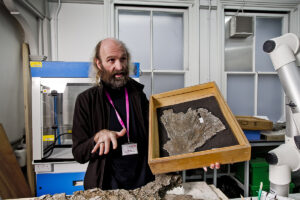 Does the study of creatures such as this tell us something about the threats we may face as a species?
Does the study of creatures such as this tell us something about the threats we may face as a species?
In a way, because of the relatively short time that humans have been around, the only way we get clues about how climate change works is by going back to look at the fossil record and seeing how environments and ecosystems have been affected in the past. For example, there’s a lot of research being focused on a stage in the early Jurassic period called the Toarcian, which is of interest to me because it’s where pachycormids first appear. There was a global anoxic event around this time, where the oxygen content of the oceans dropped dramatically, with a lot of species – such as pachycormid fish – appearing, and a lot of others disappearing, all of which seems to coincide with – and possibly be the result of – a temperature rise of 2-3.5 °C in subtropical areas and 6-8 °C at higher latitudes, as predicted for the end of this century – and we know that the consequences back then were huge. The temperature back then was generally warmer, and the water was perhaps around 14-15°C , so it would have been comfortable for swimming if it weren’t for some of the other bitey marine reptile things that were around, some of which, like the pliosaurs, were really quite big!
Did those predators pose a threat to Leedsichthys?
If you look at the type specimen in the Natural History Museum in London, they have this section of the dorsal fin of the animal with bite marks where pliosaur teeth have broken the bones on several neighbouring fin rays. What’s nice about it is that you can follow the marks on adjacent rays, so you can actually get the shape of the mouth and work out how big the pliosaur was – about 6 metres long. But the really interesting part is that all the bones have healed, which means it swam away after the encounter and carried on with its life. Basically, it was able to survive an attack by the most ferocious alpha predator in the ecosystem, which just goes to show this wasn’t just some big floating victim waiting to be a meal. The example in the Natural History Museum in London, which is slightly bigger than this one – about 9 metres long – has a tail 2.74 metres high. That’s got quite a lot of power in terms of driving the animal forward and out of danger, and you start to realise that even though the animal was quite large, it was able to put on a burst of speed for those vital few seconds that could get it out of danger.
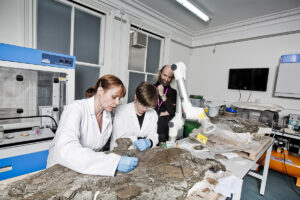 What will people be able to actually see of Leedsichthys?
What will people be able to actually see of Leedsichthys?
The problem with putting it on display is its sheer size. The gallery can’t take a reconstruction – it’s just too large. The fish grew up to 16.5 metres and while the example we have here is smaller – probably about 8 metres long – it’s also by far the most complete of the 71 examples of Leedsichthys found worldwide. So the main thrust of the project is to put it online and make it accessible not just for researchers, but for anybody online to browse, with as many of the bones photographed as possible. You can access it all at thebigjurassicfish.com, which has all sorts of additional information that we couldn’t hope to present within a museum environment.












